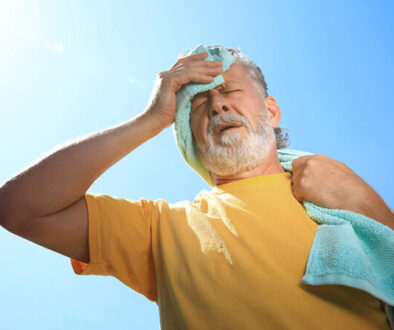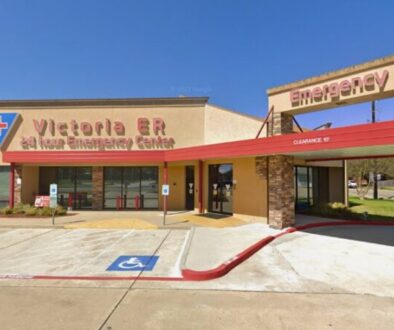Heat-related illnesses: when it’s an emergency
Texas summers often bring dangerous heat and a higher risk of heat-related illnesses (e.g., dizziness, nausea or confusion).
At Victoria ER, we understand how concerning these signs can feel. Our board-certified ER physicians provide fast, accurate care, typically seeing patients within five minutes.
Knowing the warning signs and when to seek emergency care is essential. Our team is here to ensure you receive the safe and compassionate care you need and deserve.
Why Texas summers increase heat illness risk
High temperatures and the heat index
When air temperatures rise above 90°F and humidity climbs along with it, the heat index can feel unbearable.
What happens next is the body struggles to regulate its internal temperature, increasing your risk of heat exhaustion and heat stroke.
Local weather patterns in The Crossroads region
Victoria, TX, and its surrounding areas often experience long stretches of intense summer heat, which increases the risk of heat-related illnesses. This region can also be affected by hurricanes and tropical storms, which bring higher humidity and sometimes disrupt power. This means cooling systems like fans and air conditioners can be impacted, making heat sickness more likely for residents in The Crossroads.
Outdoor workers, athletes, and families who enjoy spending time outside are particularly vulnerable, so it’s important to take precautions and know when and where to seek emergency care.
Common heat-related illnesses
Heat exhaustion (symptoms, first aid, when to rest)
Symptoms
- Heavy sweating
- Weakness or fatigue
- Dizziness or lightheadedness
- Nausea or vomiting
- Rapid heartbeat or shallow breathing
- Headache
First aid
- Move to a cooler, shaded area
- Drink water or electrolyte beverages
- Loosen or remove excess clothing
- Apply cool, damp cloths to the skin
- Seek medical care if symptoms do not subside or get worse
When to rest
- Avoid physical activity until fully recovered
- Rest in an air-conditioned or well-ventilated area
- Monitor for worsening symptoms, signaling possible heat stroke
Heat stroke (life-threatening signs, immediate ER visit)
Come to Victoria ER right away if you have any life-threatening signs of heat stroke, such as:
- Confusion, agitation, or slurred speech
- Loss of consciousness or seizures
- Hot, dry, or flushed skin
- Body temperature above 104°F
- Rapid, weak pulse
Heat cramps (often an early warning sign)
According to Healthline, heat cramps are an early warning sign of heat exhaustion or heat stroke. They typically affect the muscles during or after intense activity in hot weather. While they’re not usually dangerous on their own, they are a warning sign that it’s time to rest, rehydrate, and cool down to prevent more serious heat-related illnesses.
When it’s time to seek emergency care
Red-flag symptoms you shouldn’t ignore
MedlinePlus says if you or a loved one is experiencing a body temperature above 104°F, extreme confusion, irrational behavior, or seizures, seek immediate emergency care.
The board-certified ER physicians at Victoria ER treat all types of heat emergencies and ensure that all patients receive rapid, personalized care in private exam rooms.
What Victoria ER can do for heat emergencies
Our board-certified emergency physicians and clinical team in Victoria, TX, provide fast, high-quality care for heat stroke and other heat emergencies, including dehydration, helping to stabilize patients quickly and safely.
Our treatments include:
- Physical assessment and symptom check
- Vital sign evaluation
- IV fluids and electrolyte replacement (if needed)
- Cooling methods to reduce body temperature
- Continuous monitoring to prevent heat illness complications
- Close coordination with specialists (if advanced care is needed)
Special risks for children, seniors, and outdoor workers
Why some people are more vulnerable
Children, older adults and those working outdoors or in poorly ventilated environments are more likely to experience heat sickness because their bodies struggle to regulate temperature effectively.
Children have smaller bodies that are prone to heat-related illness, older adults may have underlying medical conditions or take medications that affect their heat response, and outdoor workers are often exposed to high temperatures and humidity for extended periods.
Understanding these risks can help you take the necessary precautions and know when it’s time to seek emergency care.
How to protect higher-risk groups
Check in on children, older adults and coworkers during heat waves and take proactive steps to protect these higher-risk groups:
- Encourage them to drink water or electrolyte drinks often.
- Limit heat exposure, especially during peak hours (10 a.m. and 4 p.m.).
- Encourage them to stay cool in shaded areas, near fans, or in air-conditioned spaces (e.g., at home or public cooling centers).
- Remind them to wear lightweight, loose-fitting and light-colored clothing.
- Watch for dizziness, nausea, heavy sweating or confusion. Act quickly if any signs appear.
These precautions can help lower the risk of heat illness and ensure high-risk groups receive prompt care if needed.
FAQs
What’s the difference between heat exhaustion and heat stroke?
Heat exhaustion causes weakness, dizziness and nausea, while heat stroke is a life-threatening condition, often causing confusion, seizures or loss of consciousness.
Can heat stroke happen indoors?
Yes. Heat stroke can occur indoors, especially in poorly ventilated spaces with high temperatures or during heatwaves.
How fast can heat-related illness become life-threatening?
Heat stroke can develop within minutes if the body is unable to regulate its temperature. When this happens, emergency care is crucial.
What’s the best first aid until help arrives?
Keep the individual cool: move the person to a cooler area, remove excess clothing, apply damp cloths or ice packs and give fluids if they are conscious.
For severe symptoms, go to Victoria ER right away to prevent complications.
Victoria ER: your 24/7 emergency resource
Go to Victoria ER for immediate care of heat exhaustion in Victoria, TX. You do not need an appointment. Walk in any time for an immediate evaluation and prompt heat stroke treatment. Our emergency medical services ensure you receive prompt, accurate and compassionate care.
- Address: 6703 N Navarro St, Victoria, TX 77904
- Hours: Open 24/7, 365 days a year
- Phone: (361) 573-1500
Get Directions: Search “Victoria ER Navarro St” in your maps app.





